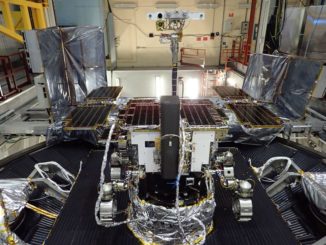
A high-resolution camera on NASA’s Mars Reconnaissance Orbiter has spotted the Perseverance rover after landing on the Red Planet last month, showing the nuclear-powered robot sitting on the Martian surface with its supersonic parachute and other landing system components scattered nearby.
MRO’s High Resolution Imaging Science Experiment, or HiRISE, camera captured views the Perseverance rover at Jezero Crater on multiple passes over the landing site after the craft’s arrival at the Red Planet on Feb. 18. An image from HiRISE taken Feb. 24 shows the rover and its surroundings in false-color, with scars on the Martian surface carved by Perseverance’s retrorockets just before touchdown.
The HiRISE instrument is the most powerful camera ever sent to another planet. Developed at the University of Arizona, the camera has a telescope and is used to map the Martian surface, study the planet’s geology, and scout landing sites for future missions.
MRO captured the Feb. 24 image of Perseverance from a distance of about 180 miles (290 kilometers) away, according to NASA’s Jet Propulsion Laboratory. The rover measures about 10 feet by 9 feet (3 by 2.7 meters) in size.

The Mars orbiter also caught a glimpse of the rover’s parachute a couple of miles to the northwest of Perseverance’s landing site. The parachute deployed after the rover entered the atmosphere and slowed the spacecraft to subsonic speed. That was followed by jettison of the spacecraft’s heat shield, which plummeted to the Martian surface. Its wreckage was located to the east of the rover’s landing site.
About a minute before touchdown, the parachute and the top part of the rover’s aeroshell, called the backshell, separated and a rocket-powered jetpack guided Perseverance the rest of the way to the surface. Eight variable-thrust rocket engines took out the rest of the rover’s vertical velocity, and the robot lowered under the descent stage on three nylon bridles.
Perseverance touched down on its six wheels, and the descent stage cut its connection to the rover and flew to the northwest in a divert maneuver to escape to a safe distance away from the rover. The descent stage’s impact site is also visible in MRO’s HiRISE imagery.
Perseverance is on a $2.7 billion mission to study whether the Jezero Crater site, which once harbored a lake of liquid water, was ever habitable for ancient Martian life forms. The rover landed near sediments deposited by a dried-up river that fed into the lake at Jezero, and scientists plan to drive Perseverance onto the delta deposits to collect rock samples for eventual return to Earth.

The one-ton Mars rover also carries instruments to track Martian weather, measure the composition of rocks, and has the first microphone and zoom-capable camera to fly to the Red Planet.
Perseverance also has an instrument to demonstrate the production of oxygen from carbon dioxide in Mars’s atmosphere, a capability that could help future human space travelers.
Email the author.
Follow Stephen Clark on Twitter: @StephenClark1.



